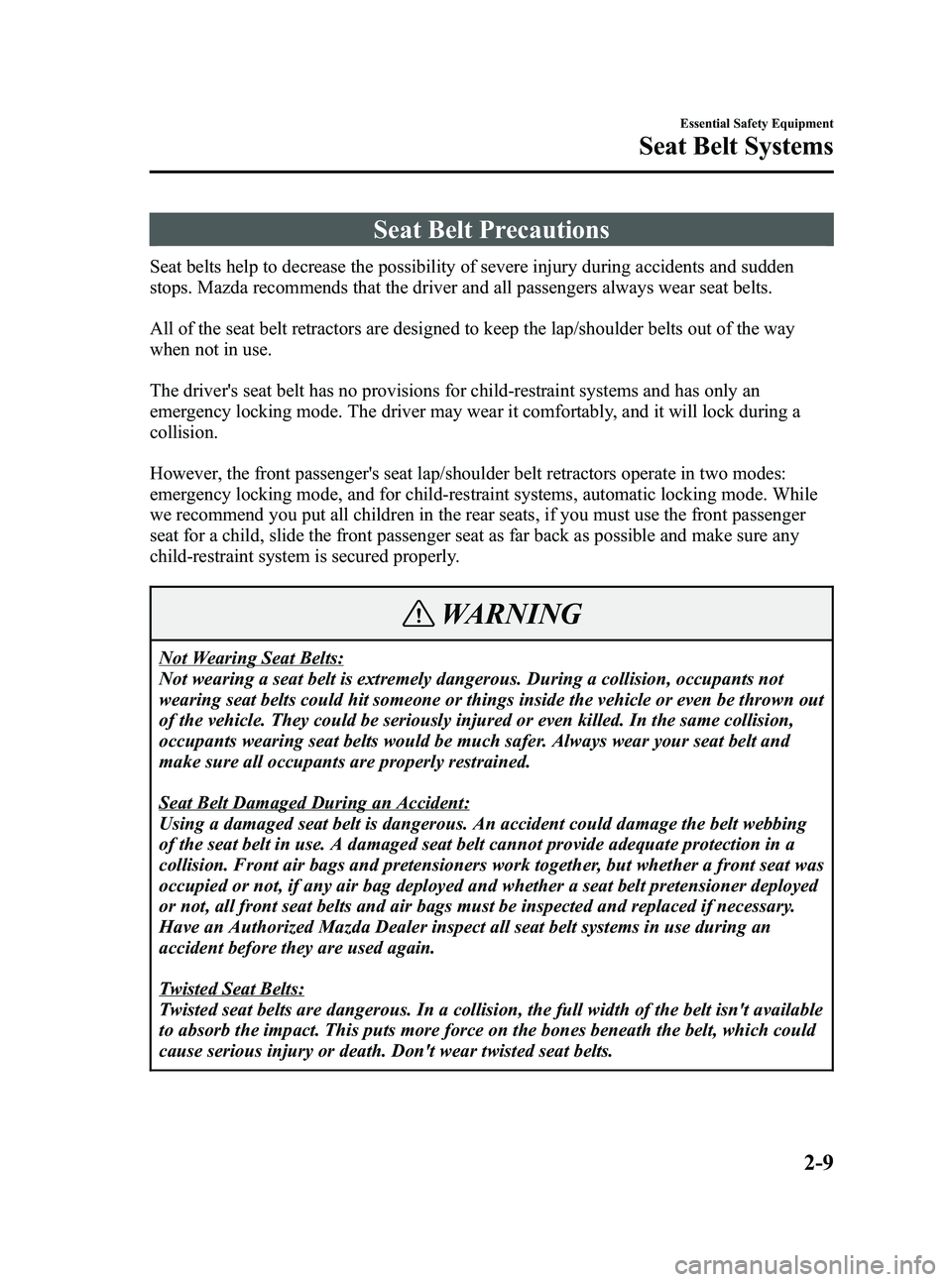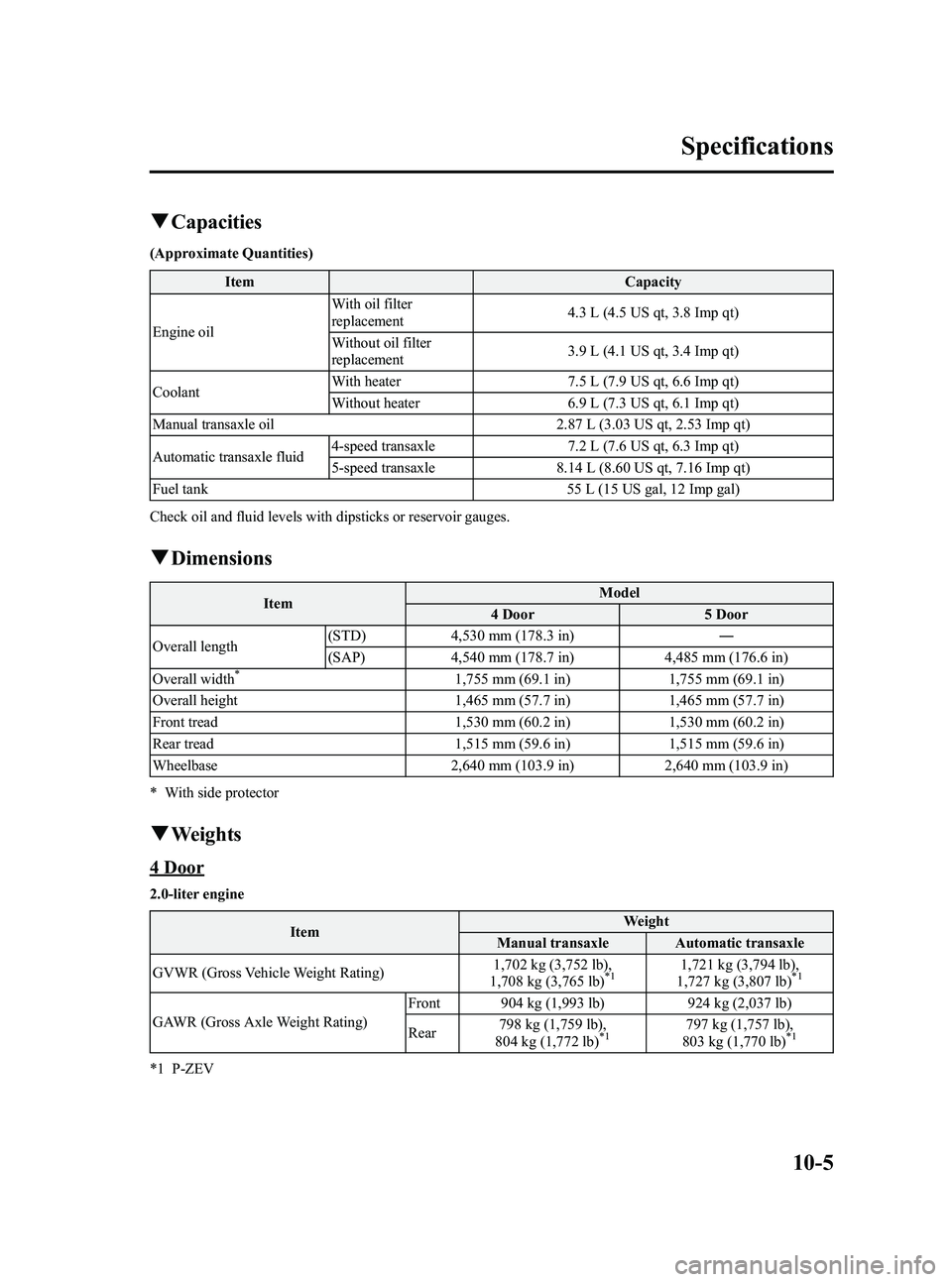width MAZDA MODEL 5 2006 Owners Manual
[x] Cancel search | Manufacturer: MAZDA, Model Year: 2006, Model line: MODEL 5, Model: MAZDA MODEL 5 2006Pages: 426, PDF Size: 7.18 MB
Page 23 of 426

Black plate (23,1)
Seat Belt Precautions
Seat belts help to decrease the possibility of severe injury during accidents and sudden
stops. Mazda recommends that the driver and all passengers always wear seat belts.
All of the seat belt retractors are designed to keep the lap/shoulder belts out of the way
when not in use.
The driver's seat belt has no provisions for child-restraint systems and has only an
emergency locking mode. The driver may wear it comfortably, and it will lock during a
collision.
However, the front passenger's seat lap/shoulder belt retractors operate in two modes:
emergency locking mode, and for child-restraint systems, automatic locking mode. While
we recommend you put all children in the rear seats, if you must use the front passenger
seat for a child, slide the front passenger seat as far back as possible and make sure any
child-restraint system is secured properly.
WARNING
Not Wearing Seat Belts:
Not wearing a seat belt is extremely dangerous. During a collision, occupants not
wearing seat belts could hit someone or things inside the vehicle or even be thrown out
of the vehicle. They could be seriously injured or even killed. In the same collision,
occupants wearing seat belts would be much safer. Always wear your seat belt and
make sure all occupants are properly restrained.
Seat Belt Damaged During an Accident:
Using a damaged seat belt is dangerous. An accident could damage the belt webbing
of the seat belt in use. A damaged seat belt cannot provide adequate protection in a
collision. Front air bags and pretensioners work together, but whether a front seat was
occupied or not, if any air bag deployed and whether a seat belt pretensioner deployed
or not, all front seat belts and air bags must be inspected and replaced if necessary.
Have an Authorized Mazda Dealer inspect all seat belt systems in use during an
accident before they are used again.
Twisted Seat Belts:
Twisted seat belts are dangerous. In a collision, the full width of the belt isn't available
to absorb the impact. This puts more force on the bones beneath the belt, which could
cause serious injury or death. Don't wear twisted seat belts.
Essential Safety Equipment
Seat Belt Systems
2-9
Mazda3_8U55-EA-05G_Edition3 Page23
Tuesday, September 13 2005 10:40 AM
Form No.8U55-EA-05G
Page 289 of 426

Black plate (289,1)
CAUTION
lA wrong-sized wheel may adversely
affect:
lTire fitlWheel and bearing lifelGround clearancelSnow-chain clearancelSpeedometer calibrationlHeadlight aimlBumper heightlTire Pressure Monitoring System
l(With Tire Pressure Monitoring
System)
lWhen replacing/repairing the tires
or wheels or both, have the work
done by an Authorized Mazda
Dealer, or the tire pressure sensors
may be damaged.
lThe wheels equipped on your
Mazda are specially designed for
installation of the tire pressure
sensors. Do not use non-genuine
wheels, otherwise it may not be
possible to install the tire pressure
sensors.
NOTE
Be sure to install the tire pressure
sensors whenever tires or wheels are
replaced. Refer to Tires and Wheels on
page 5-25.
When replacing a wheel, make sure the
new one is the same as the original factory
wheel in diameter, rim width, and offset. Proper tire balancing provides the best
riding comfort and helps reduce tread
wear. Out-of-balance tires can cause
vibration and uneven wear, such as
cupping and flat spots.
Maintenance and Care
Owner Maintenance
8-41
Mazda3_8U55-EA-05G_Edition3 Page289
Tuesday, September 13 2005 10:45 AM
Form No.8U55-EA-05G
Page 334 of 426

Black plate (334,1)
WARNING
The temperature grade for this tire is established for a tire that is properly inflated and
not overloaded. Excessive speed, underinflation, or excessive loading, either
separately or in combination, can cause heat buildup and possible tire failure.
These grades will be added to the sidewalls of passenger vehicle tires over the next several
years according to a schedule established by the NHTSA and the tire manufacturers.
The grade of tires available as standard or optional equipment on Mazda vehicles may vary
with respect to grade.
ALL PASSENGER VEHICLE TIRES MUST CONFORM TO THESE GRADES AND
TO ALL OTHER FEDERAL TIRE-SAFETY REQUIREMENTS.
q Uniform Tire Quality Grading
Quality grades can be found where applicable on the tire sidewall between tread shoulder
and maximum section width.
For example:
Treadwear 200 Traction AA Temperature A
TREADWEAR 200 TRACTION AA
TEMPERATURE A
UTQGS MARK (example)
9-20
Customer Information and Reporting Safety Defects
Uniform Tire Quality Grading System (UTQGS)
Mazda3_8U55-EA-05G_Edition3 Page334
Tuesday, September 13 2005 10:45 AM
Form No.8U55-EA-05G
Page 335 of 426

Black plate (335,1)
Tire Labeling
Federal law requires tire manufacturers to place standardized information on the sidewall of
all tires. This information identifies and describes the fundamental characteristics of the tire
and also provides a tire identification number for safety standard certification and in case of
a recall.
qInformation on Passenger Vehicle Tires
Please refer to the diagram below.
1. TIN: U.S. DOT tire identification number
2. Passenger car tire
3. Nominal width of tire in millimeters
4. Ratio of height to width (aspect ratio)
5. Radial
6. Rim diameter code
7. Load index & speed symbol
8. Severe snow conditions
9. Tire ply composition and materials used
10. Max. load rating
Customer Information and Reporting Safety Defects
Tire Information (U.S.A.)
9-21
Mazda3_8U55-EA-05G_Edition3 Page335
Tuesday, September 13 2005 10:45 AM
Form No.8U55-EA-05G
Page 336 of 426

Black plate (336,1)
11. Tread wear, traction and temperature grades
12. Max. permissible inflation pressure
13. SAFETY WARNING
P215/65R15 95H is an example of a tire size and load index rating. Here is an explanation
of the various components of that tire size and load index rating. Note that the tire size and
load index rating may be different from the example.
P
Indicates a tire that may be installed on cars, SUVs, minivans and light trucks as designated
by the Tire and Rim Association (T&RA).
NOTE
If your tire size does not begin with a letter this may mean it is designated by either
ETRTO (European Tire and Rim Technical Organization) or JATMA (Japan Tire
Manufacturing Association).
215
“215 ”is the nominal width of the tire in millimeters. This three-digit number gives the
width in millimeters of the tire from sidewall edge to sidewall edge. In general, the larger
the number, the wider the tire.
65
“ 65 ”is the aspect ratio. This two-digit number indicates the tire's ratio of height to width.
R
“R” is the tire construction symbol. R indicates “Radial ply construction ”.
15
“15 ”is the wheel rim diameter in inches.
95
“95 ”is the Load Index. This two-or three-digit number indicates how much weight each
tire can support.
9-22
Customer Information and Reporting Safety Defects
Tire Information (U.S.A.)
Mazda3_8U55-EA-05G_Edition3 Page336
Tuesday, September 13 2005 10:45 AM
Form No.8U55-EA-05G
Page 339 of 426

Black plate (339,1)
qInformation on Temporary Tires
Please refer to the diagram below.
1. Temporary tires
2. Nominal width of tire in millimeters
3. Ratio of height to width (aspect ratio)
4. Diagonal
5. Rim diameter code
T115/70D 16 is an example of a tire size and load index rating. Here is an explanation of
the various components of that tire size and load index rating. Note that the tire size and
load index rating may be different from the example.
T
Indicates a tire that may be installed on cars, SUVs, minivans and light trucks as designated
by the Tire and Rim Association (T&RA).
11 5
“115 ”is the nominal width of the tire in millimeters. This three-digit number gives the
width in millimeters of the tire from sidewall edge to sidewall edge. In general, the larger
the number, the wider the tire.
70
“ 70 ”is the aspect ratio. This two-digit number indicates the tire's ratio of height to width.
Customer Information and Reporting Safety Defects
Tire Information (U.S.A.)
9-25
Mazda3_8U55-EA-05G_Edition3 Page339
Tuesday, September 13 2005 10:45 AM
Form No.8U55-EA-05G
Page 363 of 426

Black plate (363,1)
qCapacities
(Approximate Quantities)
Item Capacity
Engine oil With oil filter
replacement
4.3 L (4.5 US qt, 3.8 Imp qt)
Without oil filter
replacement 3.9 L (4.1 US qt, 3.4 Imp qt)
Coolant With heater 7.5 L (7.9 US qt, 6.6 Imp qt)
Without heater 6.9 L (7.3 US qt, 6.1 Imp qt)
Manual transaxle oil 2.87 L (3.03 US qt, 2.53 Imp qt)
Automatic transaxle fluid 4-speed transaxle 7.2 L (7.6 US qt, 6.3 Imp qt)
5-speed transaxle 8.14 L (8.60 US qt, 7.16 Imp qt)
Fuel tank 55 L (15 US gal, 12 Imp gal)
Check oil and fluid levels with dipsticks or reservoir gauges.
q Dimensions
Item Model
4 Door 5 Door
Overall length (STD) 4,530 mm (178.3 in)
―
(SAP) 4,540 mm (178.7 in) 4,485 mm (176.6 in)
Overall width
*1,755 mm (69.1 in) 1,755 mm (69.1 in)
Overall height 1,465 mm (57.7 in)1,465 mm (57.7 in)
Front tread 1,530 mm (60.2 in)1,530 mm (60.2 in)
Rear tread 1,515 mm (59.6 in)1,515 mm (59.6 in)
Wheelbase 2,640 mm (103.9 in)2,640 mm (103.9 in)
* With side protector
q Weights
4 Door
2.0-liter engine
Item Weight
Manual transaxle Automatic transaxle
GVWR (Gross Vehicle Weight Rating) 1,702 kg (3,752 lb),
1,708 kg (3,765 lb)
*11,721 kg (3,794 lb),
1,727 kg (3,807 lb)*1
GAWR (Gross Axle Weight Rating) Front 904 kg (1,993 lb) 924 kg (2,037 lb)
Rear
798 kg (1,759 lb),
804 kg (1,772 lb)*1797 kg (1,757 lb),
803 kg (1,770 lb)*1
*1 P-ZEV
Specifications
10-5
Mazda3_8U55-EA-05G_Edition3 Page363
Tuesday, September 13 2005 10:45 AM
Form No.8U55-EA-05G